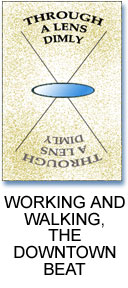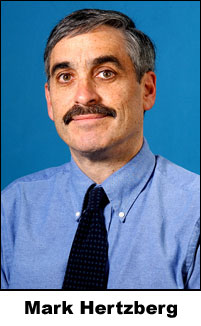WORKING AND WALKING, THE DOWNTOWN
BEAT
By Mark Hertzberg
Director of Photography
Journal Times (Racine, WI)
Dick Kraus' 'Through the Lens Dimly' stories have stirred these recollections
of my first job, as an intern in 1969 for the now-defunct Baltimore
News-American, an afternoon paper in the Hearst chain.
I had told photo editor Jack O'Brien that I did not have a driver's
license when I applied for the job (hey, I was a New York kid). They
hired me anyway. Three months later, management had a conniption when
I arrived and was given a distant assignment, and said, again, that
I did not drive. It was finally decided that I could stay and have the
assignments within walking distance of the office.
Our front page invariably had a two-line, eight column headline.
We led with a wire photo or a spot news photo by Harold Spicer. Harold
started at 6 a.m., and his sole daily assignment was to get a spot news
photo for the first edition. Harold's black Chevy looked like an unmarked
police squad car, and had a myriad of radios and antennas.
I started work on a Monday, which was Harold's day off. I was assigned
to share a developing darkroom with him. He was furious the next day,
my day off, to find out that he was stuck with the intern. Apparently
he had not gotten along well with the last intern. We got along well,
though, for the rest of the summer.
I eagerly asked Harold if I could cruise for spot news photos with
him one week on my Tuesday off. We spent the day together, though
he wondered, "Why do you want to be with me when you could be..."
One Saturday afternoon, when Spicer was not working, a high-speed
Metroliner train derailed, and Dick Tomlinson was sent to the scene.
Spicer came back to the office with Tomlinson. I was excited by the
big story, and asked Harold if he had gotten any good pictures. "@%#,
no, kid, today's my day off; I shot home movies!"
No one left the office unless they had an assignment in hand. You
never enterprised photos. There was an Unknown Soldier's tomb in
downtown Baltimore. One day I was sitting by the photo editor's phone
when it rang. I answered it and heard, "This is the City Desk.
The mother of the Unknown Soldier is coming to visit her son's tomb
in a half hour and we need it covered."
I asked Charlie 'Bam' Cullison, our 'inside', or lab, man for film
because I had been given an assignment from the desk. The other photographers
starting laughing at me and I figured that the assignment was a prank.
I had cynically thought that 'if they can put a man on the moon (that
year) they know who's in the tomb.' The call from the 'City Desk'
had come from the other end of the photo department.
Some of the photographers resisted shooting 35mm even in 1969, and
were delighted with the new Yashica Mat 124G cameras that had just
been issued to them. One photographer liked shooting with a Hanimex
Praktica, an East German 35mm camera. Our pool equipment included
two 105mm f2.5 Nikkor lenses. One focused from about 10 feet to infinity,
the other from about two feet to 30 feet, as I recall. We also had
a pool 200mm Nikkor lens and a pool 300mm f4.5 Nikkor lens. I had
my trusty Nikkormat FT camera, my 28mm, 50mm, and 135mm lenses, and
my Honeywell 65D 'potato masher' strobe.
I enjoyed shooting Orioles games at the old Memorial Stadium. I shot
a no-hitter by Jim Palmer that summer, and feasted on the free crab
cakes in the press box before every game I covered.
In those days we knelt next to the first base dugout. If a foul ball
(and Orioles first baseman Boog Powell) came our way, we just ducked
into the dugout. Neil Leifer of Sports Illustrated covered one of
the games I was shooting...he took a position behind the umpire,
as I recall.
I was proud of the pictures I took at my first game and turned them
in, along with the photos of the staff photographer assigned to the
game. The sports desk used his photos, but mistakenly credited them
to me. The staffer exploded, and told me that as an intern, I was
to NEVER turn in photos from a game he was assigned to.
I thank my colleagues Jack O'Brien, 'Bam,' Charlie Hart, John Davis,
Frank Spinek, Jim Lally, Dick Tomlinson, Vernon Price, John Stadler,
and, of course, Harold Spicer, for a memorable summer. They probably
remember me as the geek who sat and read books about the Vietnam
War between assignments.
It was a terribly lonely summer for me, but it was a great learning
experience. Though I rarely, if ever, got any feedback on my work,
my internship gave me the confidence to go on and pursue what has
become my career.
My summer in Baltimore also gave me a taste of a bygone era. There
are, of course, photographers who consider that era 'the good old
days before (fill in any complaint that comes to mind).'
Afternoon metros like the News-American have gone out of business
since then. Imagine the shock that photographers who resisted shooting
35mm would have in being told to learn how to use computers and
digital cameras.
In some respects, we may not have as much fun today as our predecessors
did (or think they did), but there have been vast improvements
in our profession. In addition to our technological advantages,
today
we have ethics codes; we often have more of a voice in the newsroom;
and we help our interns improve their work. Perhaps most significantly,
you no longer have to be a white male to get hired.
My responsibilities include hiring. I look forward to one day reading
the perspective of people I have hired, as they look back on our
work together, perhaps wistfully looking back on 'the good old
days.'
Mark Hertzberg
hertz@wi.net


